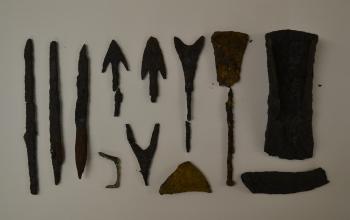Items excavated from Inagi City Tatedai Ruins
Updated: October 29, 2018

Haji ware, Sue ware, and ash-glazed pottery from the Nara and Heian periods
Inagi City Tatedai Ruins
Hundred Villages Tatejinja Shrine On the plateau that spreads to the southeast, Inagi City Tatedai Ruins There was. Excavations was carried out, Jomon period and Nara・Heian Period Centered on Ruins It was discovered that Remains In the Jomon period, Remains of a pit dwelling 5 houses, For hunting of Recess death hole Earth Pit 310 units, Nara・Heian Period So Remains of a pit dwelling 78 houses, Remains of a post-hole building 41 houses, Pottery firing For Pit ruins 5 houses, etc. Remains teeth Nara・Heian Period of Remains of a residence and Remains of a post-hole building It was discovered that it was operated intermittently between the 8th and 11th centuries.
These Remains From a large amount Earthenware or Stone tools , Ironware etc. Relics but Excavated However, there were some particularly important Excavated items 123 of the items have been designated as tangible cultural properties of Inagi City.
Jomon Period Materials
Jomon Period The materials are pottery from the early and middle periods. Remains of a pit dwelling From among Excavated Did. Jomon Period Previous period Deep bowl-shaped pottery 1 point, mid-term Deep bowl-shaped pottery 2 points, mid-term Tableware stand One piece of pottery from the early period and one piece of pottery from the middle period are Cooking It is believed that the remaining pottery from the Middle Period was found in a house. Furnace It was used as a. Tableware stand It is 9.7 centimetres high and 15 centimetres in diameter and was used as a stand to place things. Excavated This is a document with few examples.
Materials from the Nara and Heian periods
There are a total of 119 items from the Nara and Heian periods. Hajiki pottery and Sue ware 67 points, Green Glazed Pottery and Ash-glazed pottery 6 items, 34 iron tools, and 12 other items.
[ Hajiki pottery and Sue ware 】
Hajiki pottery teeth Yayoi pottery Continuing the tradition of low temperature Firing Brownish-red Earthenware As a reference material Long-bodied jar , Pottery , Steamer , Pedestal jar , Pottery bowl , Feather Pot There are a total of 23 items. Sue ware The pottery is shaped on a potter's wheel using techniques introduced from the Korean Peninsula. Cave kiln At high temperatures using Firing It is a gray earthenware. Pottery , Plate with high base , Bowl-shaped pottery , lid There are a total of 44 items. Hajiki pottery and Sue ware teeth, Cooking They are tools used daily in daily life, such as for cooking and tableware.
[ Ash-glazed pottery and Green Glazed Pottery 】
Ash-glazed pottery teeth, straw The raw material is plant ash such as glaze It is a slightly more high-quality item than everyday tableware, made from pottery coated with porcelain. Green Glazed Pottery teeth lead Entered glaze It is a yellow-green pottery made from porcelain. Unlike everyday items, it is high quality and was used for ceremonies. Excavated There are few examples, so this is a valuable resource. Green Glazed Pottery of Bowl , Ash-glazed pottery A bowl of Plate with high base , Long-necked bottle There are a total of six items, including:
[Iron Tools]
During the Nara and Heian periods, iron tools became widespread as weapons, agricultural implements, and daily necessities. Remains of a pit dwelling Many iron tools used at that time were discovered inside the cave. Iron Arrowhead , Iron Sickle , Iron Axe , Iron knife , Iron chisel , clamp , Iron nail , Iron spindle wheel And more.
[Other materials]
Iron tools, etc. Research Ida Grindstone , Stone of Spindle wheel , as fishing equipment Clay weight There is.

Iron tools (swords, iron arrowheads, iron axes, iron sickles, etc.)







